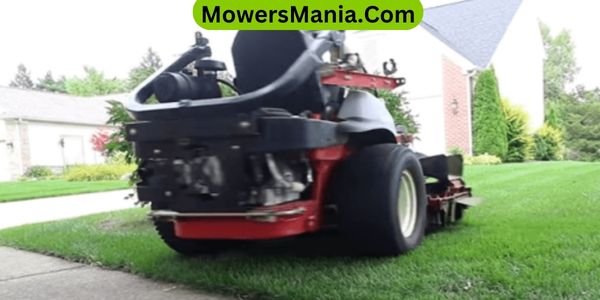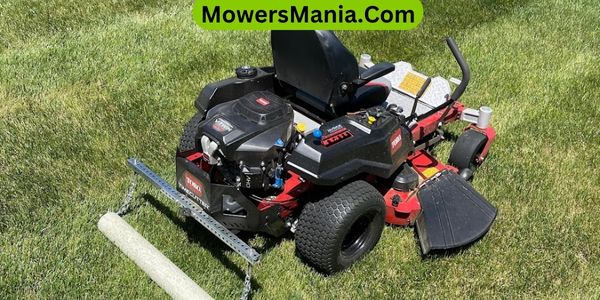When your riding lawn mower blade won’t engage, it can be frustrating and inconvenient. However, with a few simple steps, you can troubleshoot and fix the issue yourself.
By checking the PTO switch, inspecting the PTO clutch, examining the belt and pulleys, testing the safety interlock system, verifying the blade engagement cable, and evaluating the mower deck alignment, you can identify and resolve the problem efficiently.

This guide will walk you through the process of getting your riding lawn mower blade back to working condition, ensuring that you can maintain your lawn with ease.
Check the PTO Switch
If your riding lawn mower blade won’t engage, the first step is to check the functionality of the PTO switch. The PTO (Power Take Off) switch is responsible for engaging the blades on your riding lawn mower.
Start by making sure that the PTO switch is in the ‘on’ position. Sometimes, due to vibration during operation, the switch can move to the ‘off’ position, preventing the blades from engaging.
If the switch is in the correct position, inspect the wiring connected to the PTO switch for any signs of damage or wear. Frayed or damaged wires can disrupt the electrical connection and prevent the blades from engaging properly.
Additionally, check for any corrosion or loose connections in the wiring, as these can also cause issues with the PTO switch.
If everything appears to be in working order, it’s possible that the PTO switch itself is faulty and may need to be replaced.
Inspect the PTO Clutch
To inspect the PTO clutch on your riding lawn mower, first locate the clutch assembly under the mower deck. The PTO clutch is responsible for engaging the blades when the mower is running.
Start by checking for any visible signs of damage such as cracks or wear on the clutch assembly. Ensure that the clutch is properly aligned and that all the mounting bolts are securely in place.
Next, examine the wires connected to the clutch for any signs of fraying or damage. If everything looks intact, test the clutch by engaging and disengaging it while observing its operation. Listen for any unusual noises or grinding sounds that might indicate a problem with the clutch mechanism.
Additionally, check the voltage going to the clutch to ensure it’s receiving the correct amount of power.
If you notice any issues during this inspection, it may be necessary to replace the PTO clutch to resolve the problem of the riding lawn mower blade not engaging.
Examine the Belt and Pulleys

You can start by looking under the mower deck to inspect the belt and pulleys.
Here are some steps to guide you through the process:
- Check the condition of the belt: Look for any signs of wear, tear, or damage on the belt. If it appears frayed or cracked, it may need to be replaced.
- Tighten the belt: Ensure that the belt is properly tensioned. If it feels loose or slips easily, it may need to be adjusted or replaced.
- Inspect the pulleys: Examine the pulleys for any debris, damage, or signs of misalignment. Clean out any debris that may be causing the pulleys to malfunction.
- Look for obstructions: Check for any obstructions, such as grass clippings or debris, that may be preventing the belt from engaging properly.
- Lubricate the pulleys: Apply lubricant to the pulleys to ensure smooth operation and reduce friction.
Test the Safety Interlock System
Once you have examined the belt and pulleys, it’s essential to test the safety interlock system to ensure proper functionality of the riding lawn mower blade.
Begin by sitting in the operator’s seat and engaging the parking brake. Next, attempt to start the mower without depressing the clutch/brake pedal or engaging the blades. If the engine starts, your safety interlock system may not be functioning correctly.
Another test involves starting the engine, disengaging the parking brake, and then attempting to engage the blades without sitting in the operator’s seat. The blades shouldn’t engage in this scenario. If they do, it indicates a safety interlock issue.
Additionally, check the wiring and connections related to the safety interlock system for any signs of damage or wear. If everything seems to be in order, but the blades still won’t engage, it might be time to consult a professional for further diagnosis and repair.
Verify the Blade Engagement Cable
First, check the cable connection to ensure it’s securely attached to the engagement lever.
Then, inspect the cable for any signs of damage, such as fraying or kinks, that may be preventing it from properly engaging the blade.
If you notice any issues with the cable, it may need to be repaired or replaced to restore proper functionality to your riding lawn mower’s blade engagement system.
Check Cable Connection
To ensure proper engagement of the riding lawn mower blade, there are several steps you can take. First, locate the blade engagement cable near the mower deck.
Make sure that the cable is properly connected to the engagement lever. Check for any signs of damage or wear on the cable and connection points. It’s important to test the cable by engaging and disengaging the blade to see if it moves freely.
If you find that the cable is damaged or not connected correctly, reattach or replace it as needed. By checking the cable connection and verifying the blade engagement cable, you can address any issues that may be preventing the riding lawn mower blade from engaging properly.
Inspect Cable for Damage
Inspecting the blade engagement cable for damage is crucial to ensuring proper functioning of the riding lawn mower blade.
Begin by locating the cable, which is usually connected to the blade engagement lever. Check the entire length of the cable for any signs of wear, fraying, or kinking.
It’s essential to ensure that the cable isn’t tangled or obstructed in any way. If you notice any damage, it’s important to replace the cable to guarantee smooth blade engagement.
Additionally, make sure that the cable is properly connected at both ends and that there are no loose or missing fasteners.
Evaluate the Mower Deck Alignment

First, check the positioning of the mower blades to ensure they’re properly aligned.
Then, inspect the tension of the mower belt to see if it needs adjustment.
Check Blade Positioning
You can identify if the riding lawn mower blade won’t engage by checking the positioning of the blade and evaluating the alignment of the mower deck. Here are some key steps to help you check the blade positioning and assess the mower deck alignment:
- Inspect the blade for any signs of damage or obstruction.
- Ensure that the blade is properly attached to the spindle and that the mounting hardware is secure.
- Examine the mower deck for any visible misalignments or irregularities.
- Measure the blade height to confirm it’s within the manufacturer’s recommended range.
- Test the engagement mechanism to see if it operates smoothly and efficiently.
Inspect Belt Tension
To ensure the proper engagement of the riding lawn mower blade, carefully assess the belt tension as it directly impacts the alignment of the mower deck.
Start by turning off the mower and disconnecting the spark plug wire for safety. Then, visually inspect the belt for any signs of wear, cracks, or damage.
Check the tension of the belt by pressing down on it at the midpoint between the pulleys. It should deflect slightly but not excessively. If the belt tension seems incorrect, refer to the manufacturer’s guidelines for adjusting it.
Additionally, ensure that the mower deck is properly aligned and level. Misaligned deck can cause belt tension issues and lead to poor blade engagement.
Regularly inspecting and adjusting the belt tension and mower deck alignment can help maintain optimal performance.
Adjust Pulley Alignment
Assessing the alignment of the mower deck and adjusting pulley alignment is crucial for ensuring proper engagement of the riding lawn mower blade.
To address the issue, follow these steps:
- Check for misalignment: Look for any signs of misalignment between the pulleys and the mower deck.
- Inspect for debris: Clear any debris or buildup around the pulleys that could be affecting their alignment.
- Tighten mounting bolts: Ensure that all mounting bolts securing the pulleys are tightened securely.
- Use a straight edge: Use a straight edge to verify that the pulleys are in line with each other and the mower deck.
- Adjust as needed: If misalignment is detected, make the necessary adjustments to realign the pulleys and the mower deck.
Frequently Asked Questions [FAQs]
What Are Some Common Signs or Symptoms That Indicate the Riding Lawn Mower Blade Won’t Engage?
If your riding lawn mower blade won’t engage, common signs include a lack of cutting action, unusual noises, or the blade not spinning. Regular inspection and maintenance can help prevent these issues.
Can a Malfunctioning PTO Switch Cause the Riding Lawn Mower Blade to Not Engage?
Yes, a malfunctioning PTO switch can cause the riding lawn mower blade to not engage. Check the switch for damage or wear, and replace it if necessary. Ensure proper connection and functioning to fix the issue.
How Can I Determine if the PTO Clutch Is the Problem Causing the Blade to Not Engage?
To determine if the PTO clutch is the issue causing the blade not to engage, start by checking for loose or damaged wires, and then test the clutch using a multimeter to measure resistance and voltage.
Are There Specific Belt and Pulley Issues That Commonly Cause the Riding Lawn Mower Blade to Not Engage?
Check the belt tension and condition. Inspect the pulleys for wear or damage. Tighten or replace the belt if loose or frayed. Clean the pulleys and ensure they spin freely. Addressing these issues often resolves blade engagement problems.
What Steps Should I Take to Troubleshoot and Fix the Safety Interlock System if It’s Causing the Blade to Not Engage?
To troubleshoot the safety interlock system causing the blade to not engage, first check the seat switch and ensure it’s working properly. Then inspect the wiring and connections for any damage or corrosion. Finally, test the interlock switches for proper functionality.
Conclusion
So, if your riding lawn mower blade won’t engage, there are a few things you can check and fix to get it working again.
Start by checking the PTO switch, inspecting the PTO clutch, examining the belt and pulleys, testing the safety interlock system, verifying the blade engagement cable, and evaluating the mower deck alignment.
By following these steps, you should be able to troubleshoot and fix the issue with your riding lawn mower blade.



